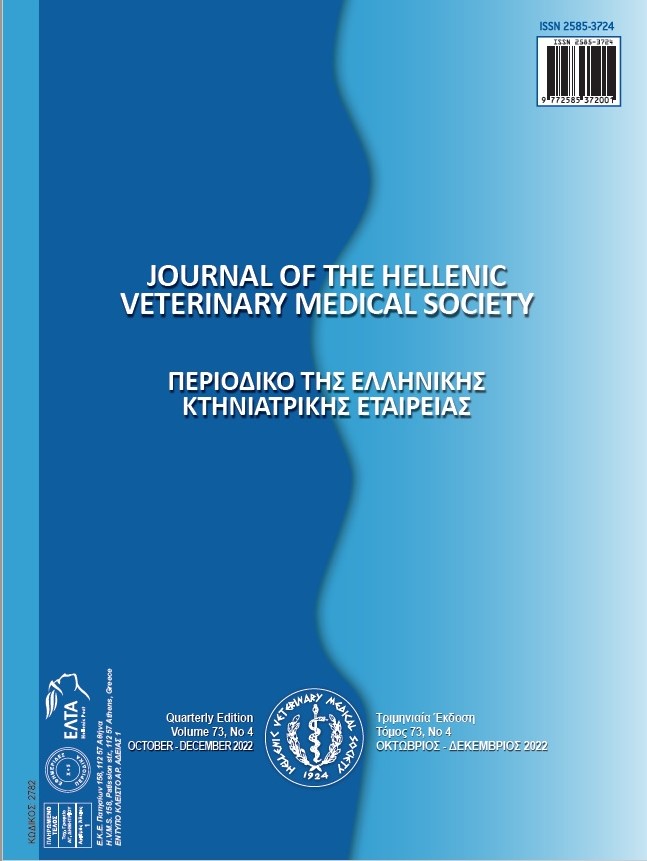Association between colostrum quality, passive transfer of colostral immunoglobulin, and postnatal growth in neonatal calves
Περίληψη
Calves that receive sufficient colostrum shortly after birth present improved passive immunity vital for optimum calf health and future production. Management practices and the dam's parity can influence colostrum quality and the transfer of immunoglobulins to newborn calves. Cows’ parity is a modulating factor, with increased IgG in older cows, although scarce information exists regarding first- and second-parity cows. This study aimed to determine the impact of parity on colostrum immunoglobulin (IgG) concentration, transfer of passive immunity, postnatal growth, and incidence of diseases in Holstein calves. The study included 60 animals, Holstein cows and their progeny that were distributed into three groups: G1 (first-parity, n=10+10), G2 (second-parity, n=10+10), and G3 (third-parity, n=10+10). The birthweight and sex of the calves were recorded. Immediately after birth, colostrum IgG was determined by colostrometer and refractometry. Blood samples from calves were collected at birth and 48 h of life to determine the transfer of passive immunity (TPI). Subsequently, the incidence of diseases, daily liveweight gain, and mortality were recorded weekly up to weaning. Birth weight tended to differ among groups (G1:33.0±0.9; G2 38.1±2.5; G3:38.3±1.4 kg; p=0.07). IgG concentration in colostrum at birth was greater (P < 0.05) in G3 than in G1 and G2, independently of the method used. Serum immunoglobulin concentration at birth was similar (P > 0.05) among groups, but at 48 h was higher (P < 0.05) in G3 calves. Postnatal growth and weaning weight did not differ among groups (P > 0.05). Calves of all groups presented diarrhea (P > 0.05). Two calves died, one from G1 and one from G2, with no mortality rate differences (P > 0.05) among groups. In conclusion, the older the cows, the higher the colostrum IgG concentration, increasing the passive immunity transfer in calves. The birth weight of calves among groups tended to differ, but the postnatal growth performance was similar. These results warrant more research to determine whether the reduced colostrum quality produced by first- and second-parity cows does not negatively affect the calves' post-weaning performance and age at first pregnancy.
Λεπτομέρειες άρθρου
- Πώς να δημιουργήσετε Αναφορές
-
García-Mendoza, A., Vega-Manríquez, D., Cuevas-Reyes, V., Flores-Najera, M., Almendarez-Navarro, F., Félix Santiago, E., Vázquez-García, J., Ballesteros-Rodea, G., Sims, R., Mellado, M., & Rosales-Nieto, C. (2025). Association between colostrum quality, passive transfer of colostral immunoglobulin, and postnatal growth in neonatal calves. Περιοδικό της Ελληνικής Κτηνιατρικής Εταιρείας, 75(4). https://doi.org/10.12681/jhvms.37201
- Τεύχος
- Τόμ. 75 Αρ. 4 (2024)
- Ενότητα
- Research Articles

Αυτή η εργασία είναι αδειοδοτημένη υπό το CC Αναφορά Δημιουργού – Μη Εμπορική Χρήση 4.0.
Οι συγγραφείς των άρθρων που δημοσιεύονται στο περιοδικό διατηρούν τα δικαιώματα πνευματικής ιδιοκτησίας επί των άρθρων τους, δίνοντας στο περιοδικό το δικαίωμα της πρώτης δημοσίευσης.
Άρθρα που δημοσιεύονται στο περιοδικό διατίθενται με άδεια Creative Commons 4.0 Non Commercial και σύμφωνα με την άδεια μπορούν να χρησιμοποιούνται ελεύθερα, με αναφορά στο/στη συγγραφέα και στην πρώτη δημοσίευση για μη κερδοσκοπικούς σκοπούς.
Οι συγγραφείς μπορούν να καταθέσουν το άρθρο σε ιδρυματικό ή άλλο αποθετήριο ή/και να το δημοσιεύσουν σε άλλη έκδοση, με υποχρεωτική την αναφορά πρώτης δημοσίευσης στο J Hellenic Vet Med Soc
Οι συγγραφείς ενθαρρύνονται να καταθέσουν σε αποθετήριο ή να δημοσιεύσουν την εργασία τους στο διαδίκτυο πριν ή κατά τη διαδικασία υποβολής και αξιολόγησής της.




